Literature Review: China's Family Planning Policy & Women Careers
VerifiedAdded on 2023/06/12
|29
|11612
|199
Literature Review
AI Summary
This literature review investigates the impact of China's family planning policies, including the one-child, two-child, and three-child policies, on women's careers. It examines the historical context, motivations, and consequences of these policies, particularly their effects on women's career advancement, employment opportunities, and overall gender equality in the Chinese labor market. The review analyzes various studies and perspectives on the effectiveness of these policies in addressing demographic challenges and their unintended social and economic impacts on women. It further explores women's experiences and perceptions of these policies, considering factors such as access to education, healthcare, and childcare support. The review concludes by recommending strategies to support and promote women's career advancement in China, considering the evolving family planning landscape and the need for gender-inclusive policies.
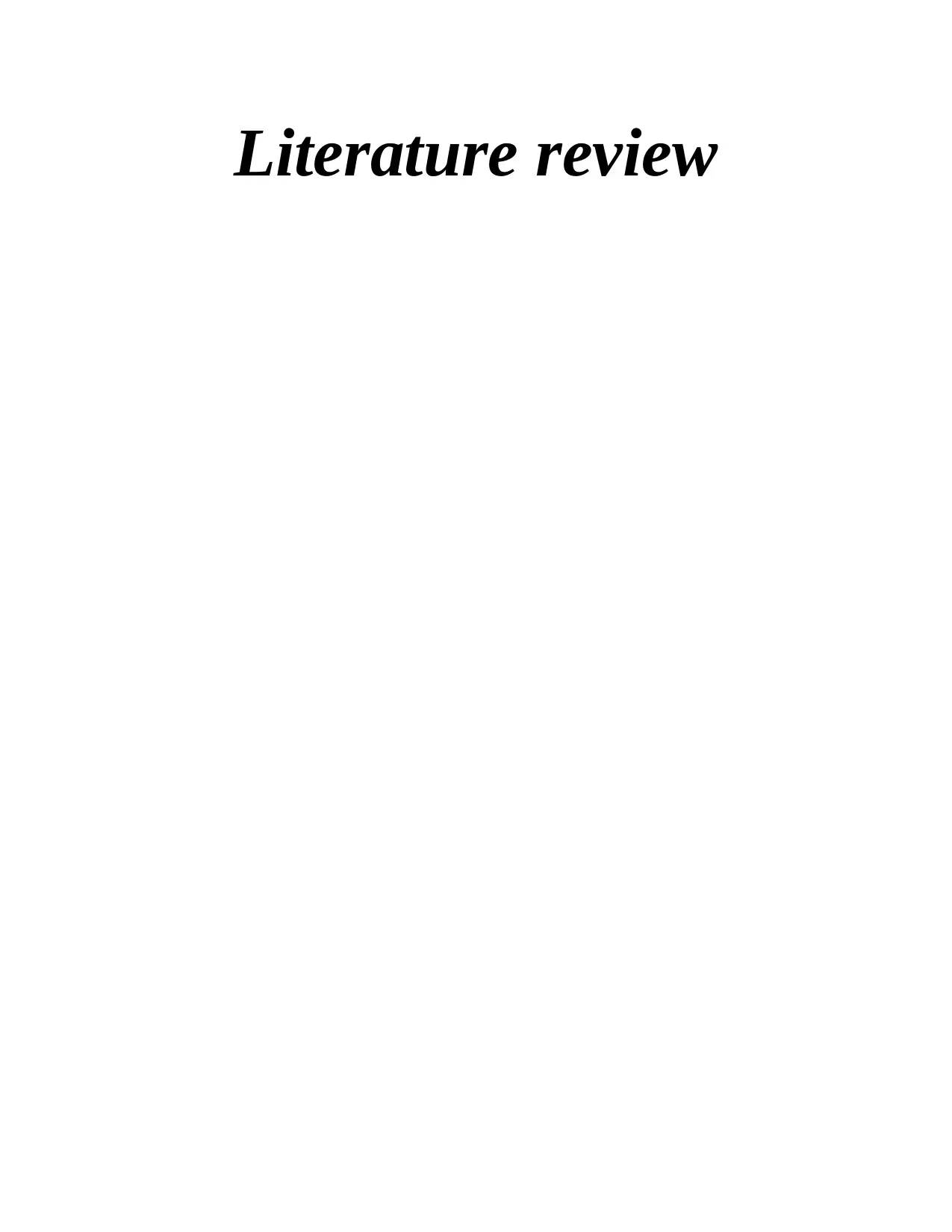
Literature review
Paraphrase This Document
Need a fresh take? Get an instant paraphrase of this document with our AI Paraphraser
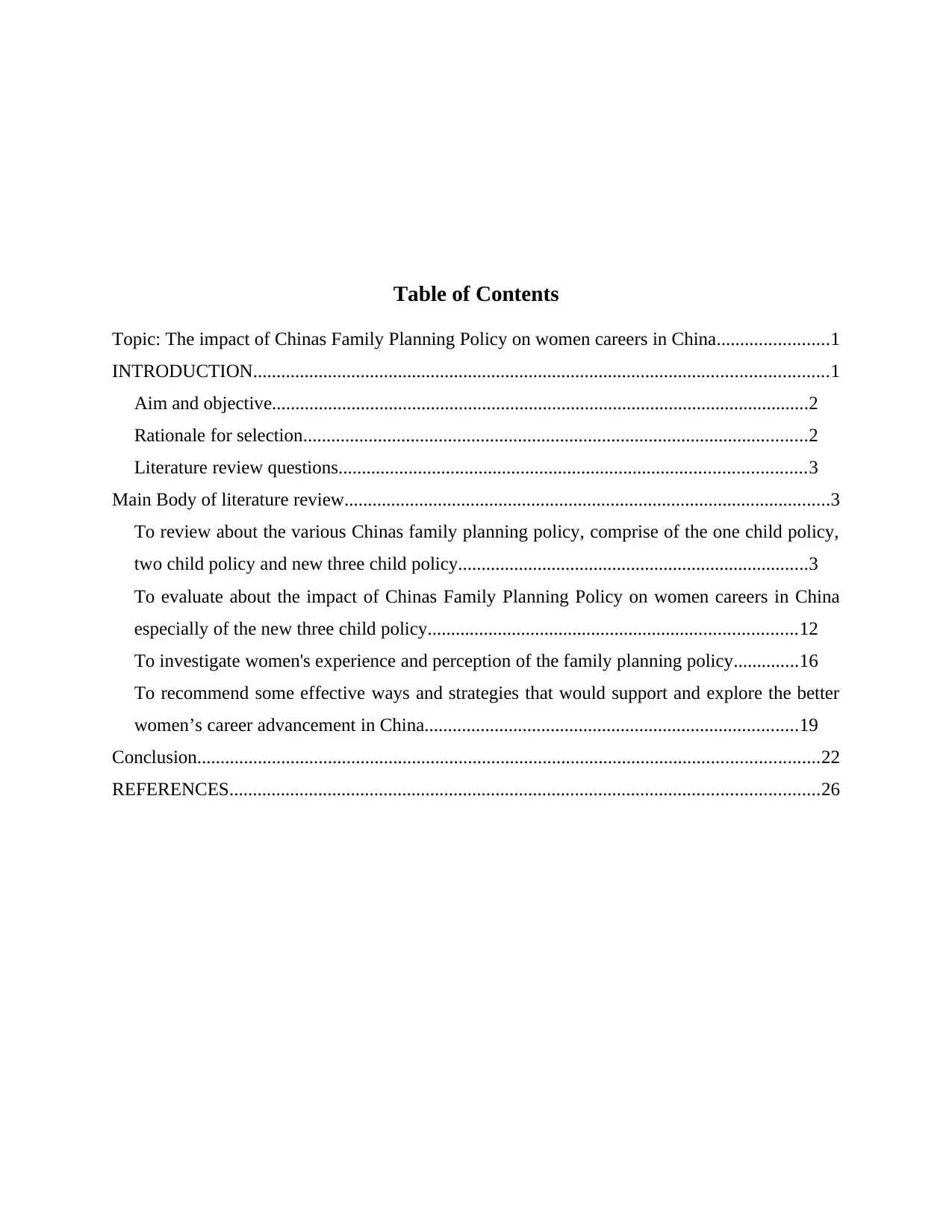
Table of Contents
Topic: The impact of Chinas Family Planning Policy on women careers in China........................1
INTRODUCTION...........................................................................................................................1
Aim and objective...................................................................................................................2
Rationale for selection............................................................................................................2
Literature review questions....................................................................................................3
Main Body of literature review........................................................................................................3
To review about the various Chinas family planning policy, comprise of the one child policy,
two child policy and new three child policy...........................................................................3
To evaluate about the impact of Chinas Family Planning Policy on women careers in China
especially of the new three child policy...............................................................................12
To investigate women's experience and perception of the family planning policy..............16
To recommend some effective ways and strategies that would support and explore the better
women’s career advancement in China................................................................................19
Conclusion.....................................................................................................................................22
REFERENCES..............................................................................................................................26
Topic: The impact of Chinas Family Planning Policy on women careers in China........................1
INTRODUCTION...........................................................................................................................1
Aim and objective...................................................................................................................2
Rationale for selection............................................................................................................2
Literature review questions....................................................................................................3
Main Body of literature review........................................................................................................3
To review about the various Chinas family planning policy, comprise of the one child policy,
two child policy and new three child policy...........................................................................3
To evaluate about the impact of Chinas Family Planning Policy on women careers in China
especially of the new three child policy...............................................................................12
To investigate women's experience and perception of the family planning policy..............16
To recommend some effective ways and strategies that would support and explore the better
women’s career advancement in China................................................................................19
Conclusion.....................................................................................................................................22
REFERENCES..............................................................................................................................26
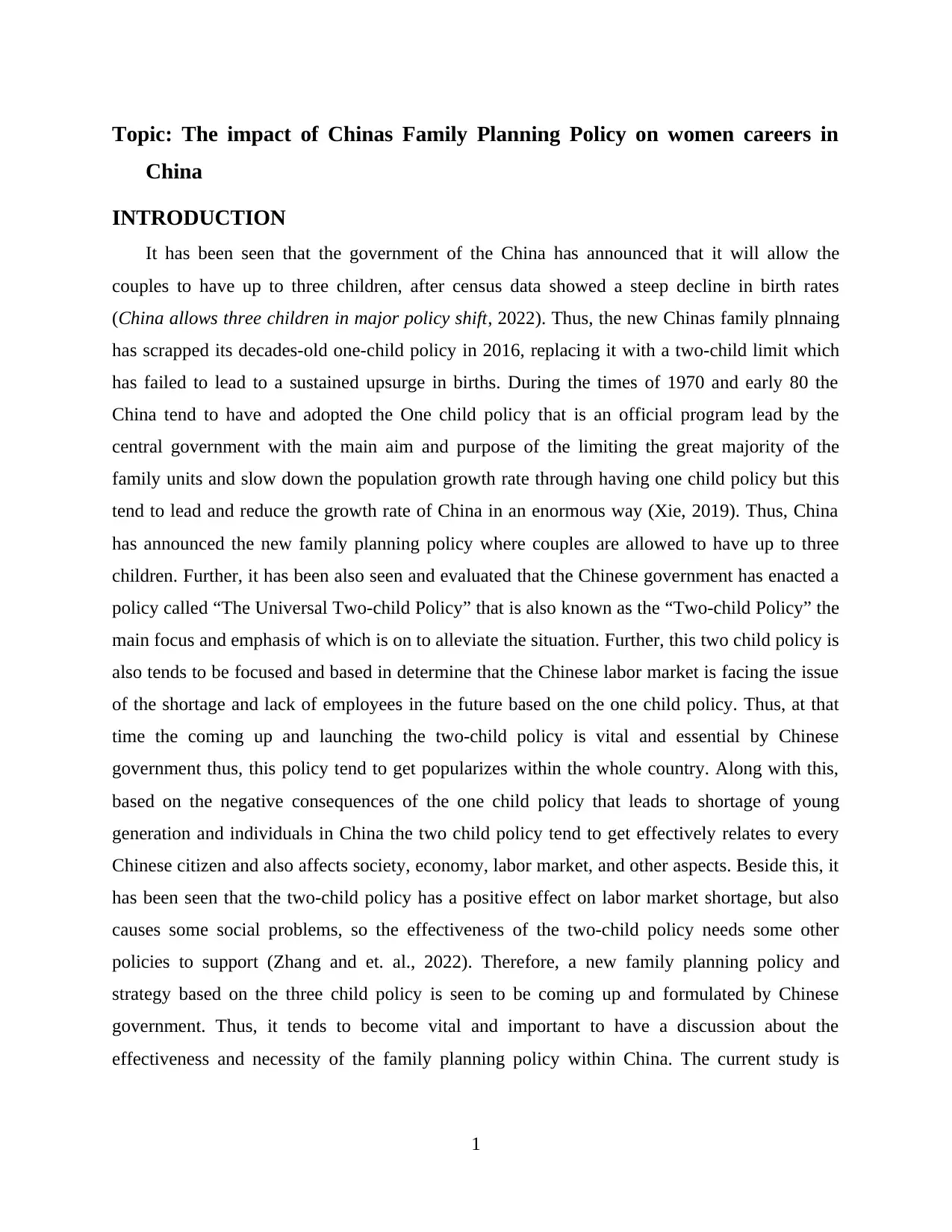
Topic: The impact of Chinas Family Planning Policy on women careers in
China
INTRODUCTION
It has been seen that the government of the China has announced that it will allow the
couples to have up to three children, after census data showed a steep decline in birth rates
(China allows three children in major policy shift, 2022). Thus, the new Chinas family plnnaing
has scrapped its decades-old one-child policy in 2016, replacing it with a two-child limit which
has failed to lead to a sustained upsurge in births. During the times of 1970 and early 80 the
China tend to have and adopted the One child policy that is an official program lead by the
central government with the main aim and purpose of the limiting the great majority of the
family units and slow down the population growth rate through having one child policy but this
tend to lead and reduce the growth rate of China in an enormous way (Xie, 2019). Thus, China
has announced the new family planning policy where couples are allowed to have up to three
children. Further, it has been also seen and evaluated that the Chinese government has enacted a
policy called “The Universal Two-child Policy” that is also known as the “Two-child Policy” the
main focus and emphasis of which is on to alleviate the situation. Further, this two child policy is
also tends to be focused and based in determine that the Chinese labor market is facing the issue
of the shortage and lack of employees in the future based on the one child policy. Thus, at that
time the coming up and launching the two-child policy is vital and essential by Chinese
government thus, this policy tend to get popularizes within the whole country. Along with this,
based on the negative consequences of the one child policy that leads to shortage of young
generation and individuals in China the two child policy tend to get effectively relates to every
Chinese citizen and also affects society, economy, labor market, and other aspects. Beside this, it
has been seen that the two-child policy has a positive effect on labor market shortage, but also
causes some social problems, so the effectiveness of the two-child policy needs some other
policies to support (Zhang and et. al., 2022). Therefore, a new family planning policy and
strategy based on the three child policy is seen to be coming up and formulated by Chinese
government. Thus, it tends to become vital and important to have a discussion about the
effectiveness and necessity of the family planning policy within China. The current study is
1
China
INTRODUCTION
It has been seen that the government of the China has announced that it will allow the
couples to have up to three children, after census data showed a steep decline in birth rates
(China allows three children in major policy shift, 2022). Thus, the new Chinas family plnnaing
has scrapped its decades-old one-child policy in 2016, replacing it with a two-child limit which
has failed to lead to a sustained upsurge in births. During the times of 1970 and early 80 the
China tend to have and adopted the One child policy that is an official program lead by the
central government with the main aim and purpose of the limiting the great majority of the
family units and slow down the population growth rate through having one child policy but this
tend to lead and reduce the growth rate of China in an enormous way (Xie, 2019). Thus, China
has announced the new family planning policy where couples are allowed to have up to three
children. Further, it has been also seen and evaluated that the Chinese government has enacted a
policy called “The Universal Two-child Policy” that is also known as the “Two-child Policy” the
main focus and emphasis of which is on to alleviate the situation. Further, this two child policy is
also tends to be focused and based in determine that the Chinese labor market is facing the issue
of the shortage and lack of employees in the future based on the one child policy. Thus, at that
time the coming up and launching the two-child policy is vital and essential by Chinese
government thus, this policy tend to get popularizes within the whole country. Along with this,
based on the negative consequences of the one child policy that leads to shortage of young
generation and individuals in China the two child policy tend to get effectively relates to every
Chinese citizen and also affects society, economy, labor market, and other aspects. Beside this, it
has been seen that the two-child policy has a positive effect on labor market shortage, but also
causes some social problems, so the effectiveness of the two-child policy needs some other
policies to support (Zhang and et. al., 2022). Therefore, a new family planning policy and
strategy based on the three child policy is seen to be coming up and formulated by Chinese
government. Thus, it tends to become vital and important to have a discussion about the
effectiveness and necessity of the family planning policy within China. The current study is
1
⊘ This is a preview!⊘
Do you want full access?
Subscribe today to unlock all pages.

Trusted by 1+ million students worldwide
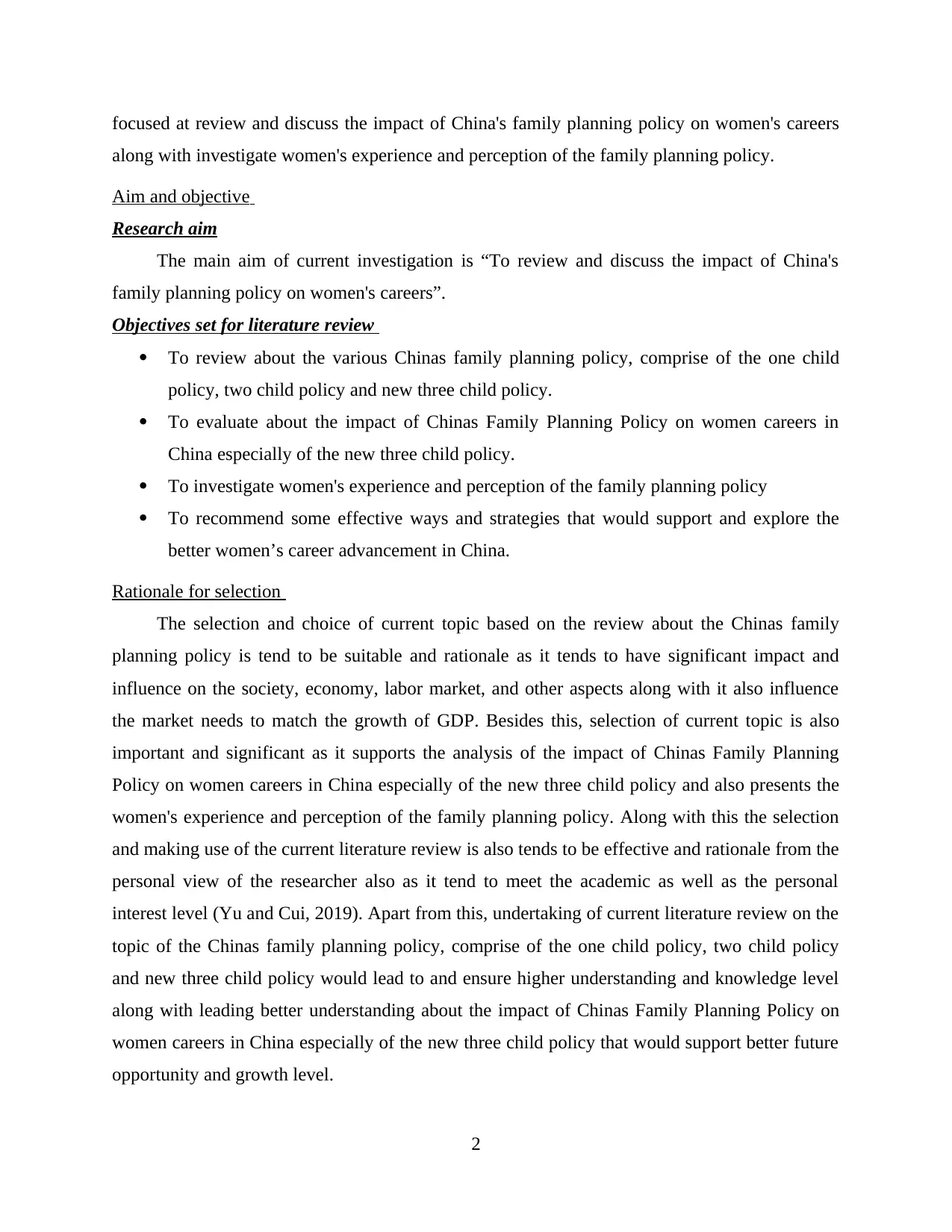
focused at review and discuss the impact of China's family planning policy on women's careers
along with investigate women's experience and perception of the family planning policy.
Aim and objective
Research aim
The main aim of current investigation is “To review and discuss the impact of China's
family planning policy on women's careers”.
Objectives set for literature review
To review about the various Chinas family planning policy, comprise of the one child
policy, two child policy and new three child policy.
To evaluate about the impact of Chinas Family Planning Policy on women careers in
China especially of the new three child policy.
To investigate women's experience and perception of the family planning policy
To recommend some effective ways and strategies that would support and explore the
better women’s career advancement in China.
Rationale for selection
The selection and choice of current topic based on the review about the Chinas family
planning policy is tend to be suitable and rationale as it tends to have significant impact and
influence on the society, economy, labor market, and other aspects along with it also influence
the market needs to match the growth of GDP. Besides this, selection of current topic is also
important and significant as it supports the analysis of the impact of Chinas Family Planning
Policy on women careers in China especially of the new three child policy and also presents the
women's experience and perception of the family planning policy. Along with this the selection
and making use of the current literature review is also tends to be effective and rationale from the
personal view of the researcher also as it tend to meet the academic as well as the personal
interest level (Yu and Cui, 2019). Apart from this, undertaking of current literature review on the
topic of the Chinas family planning policy, comprise of the one child policy, two child policy
and new three child policy would lead to and ensure higher understanding and knowledge level
along with leading better understanding about the impact of Chinas Family Planning Policy on
women careers in China especially of the new three child policy that would support better future
opportunity and growth level.
2
along with investigate women's experience and perception of the family planning policy.
Aim and objective
Research aim
The main aim of current investigation is “To review and discuss the impact of China's
family planning policy on women's careers”.
Objectives set for literature review
To review about the various Chinas family planning policy, comprise of the one child
policy, two child policy and new three child policy.
To evaluate about the impact of Chinas Family Planning Policy on women careers in
China especially of the new three child policy.
To investigate women's experience and perception of the family planning policy
To recommend some effective ways and strategies that would support and explore the
better women’s career advancement in China.
Rationale for selection
The selection and choice of current topic based on the review about the Chinas family
planning policy is tend to be suitable and rationale as it tends to have significant impact and
influence on the society, economy, labor market, and other aspects along with it also influence
the market needs to match the growth of GDP. Besides this, selection of current topic is also
important and significant as it supports the analysis of the impact of Chinas Family Planning
Policy on women careers in China especially of the new three child policy and also presents the
women's experience and perception of the family planning policy. Along with this the selection
and making use of the current literature review is also tends to be effective and rationale from the
personal view of the researcher also as it tend to meet the academic as well as the personal
interest level (Yu and Cui, 2019). Apart from this, undertaking of current literature review on the
topic of the Chinas family planning policy, comprise of the one child policy, two child policy
and new three child policy would lead to and ensure higher understanding and knowledge level
along with leading better understanding about the impact of Chinas Family Planning Policy on
women careers in China especially of the new three child policy that would support better future
opportunity and growth level.
2
Paraphrase This Document
Need a fresh take? Get an instant paraphrase of this document with our AI Paraphraser
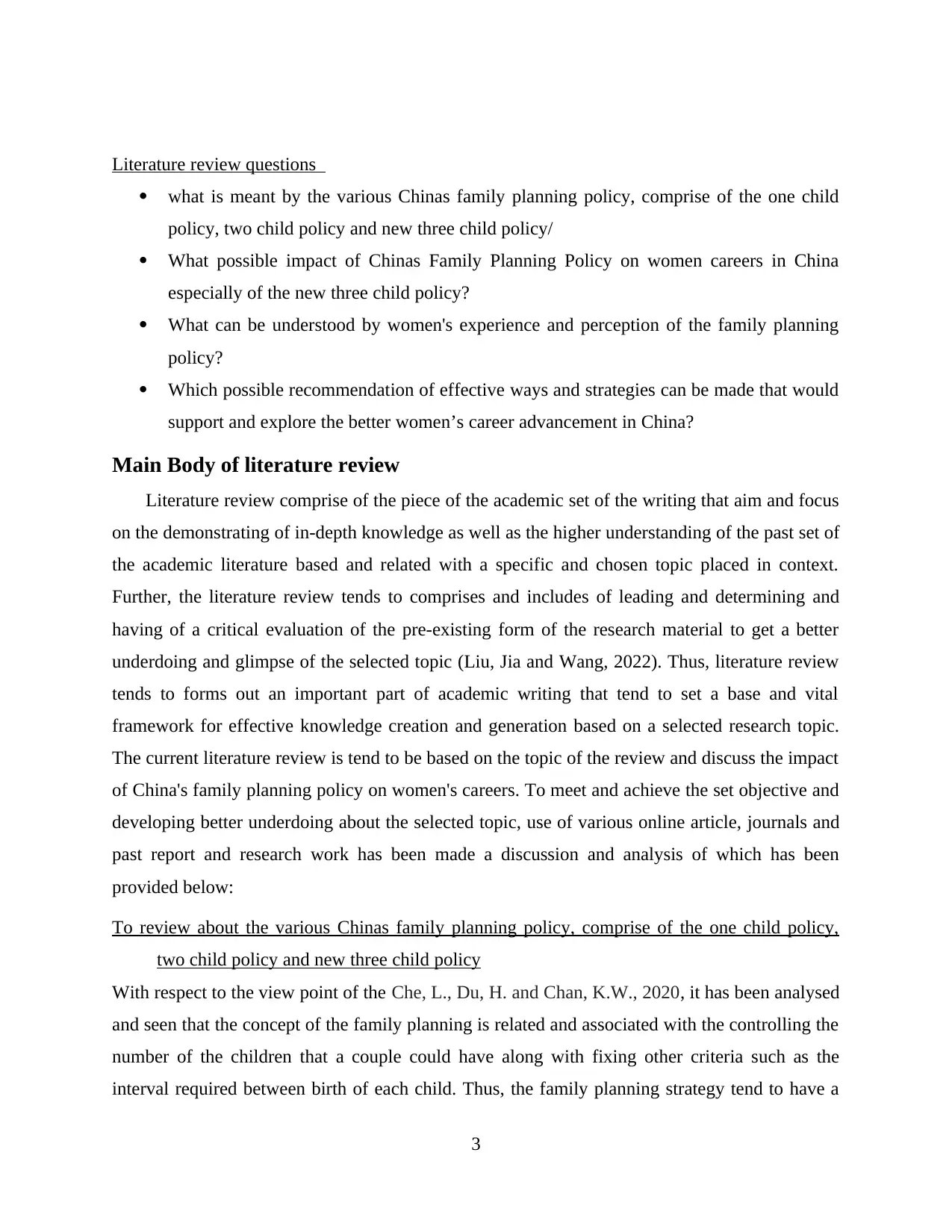
Literature review questions
what is meant by the various Chinas family planning policy, comprise of the one child
policy, two child policy and new three child policy/
What possible impact of Chinas Family Planning Policy on women careers in China
especially of the new three child policy?
What can be understood by women's experience and perception of the family planning
policy?
Which possible recommendation of effective ways and strategies can be made that would
support and explore the better women’s career advancement in China?
Main Body of literature review
Literature review comprise of the piece of the academic set of the writing that aim and focus
on the demonstrating of in-depth knowledge as well as the higher understanding of the past set of
the academic literature based and related with a specific and chosen topic placed in context.
Further, the literature review tends to comprises and includes of leading and determining and
having of a critical evaluation of the pre-existing form of the research material to get a better
underdoing and glimpse of the selected topic (Liu, Jia and Wang, 2022). Thus, literature review
tends to forms out an important part of academic writing that tend to set a base and vital
framework for effective knowledge creation and generation based on a selected research topic.
The current literature review is tend to be based on the topic of the review and discuss the impact
of China's family planning policy on women's careers. To meet and achieve the set objective and
developing better underdoing about the selected topic, use of various online article, journals and
past report and research work has been made a discussion and analysis of which has been
provided below:
To review about the various Chinas family planning policy, comprise of the one child policy,
two child policy and new three child policy
With respect to the view point of the Che, L., Du, H. and Chan, K.W., 2020, it has been analysed
and seen that the concept of the family planning is related and associated with the controlling the
number of the children that a couple could have along with fixing other criteria such as the
interval required between birth of each child. Thus, the family planning strategy tend to have a
3
what is meant by the various Chinas family planning policy, comprise of the one child
policy, two child policy and new three child policy/
What possible impact of Chinas Family Planning Policy on women careers in China
especially of the new three child policy?
What can be understood by women's experience and perception of the family planning
policy?
Which possible recommendation of effective ways and strategies can be made that would
support and explore the better women’s career advancement in China?
Main Body of literature review
Literature review comprise of the piece of the academic set of the writing that aim and focus
on the demonstrating of in-depth knowledge as well as the higher understanding of the past set of
the academic literature based and related with a specific and chosen topic placed in context.
Further, the literature review tends to comprises and includes of leading and determining and
having of a critical evaluation of the pre-existing form of the research material to get a better
underdoing and glimpse of the selected topic (Liu, Jia and Wang, 2022). Thus, literature review
tends to forms out an important part of academic writing that tend to set a base and vital
framework for effective knowledge creation and generation based on a selected research topic.
The current literature review is tend to be based on the topic of the review and discuss the impact
of China's family planning policy on women's careers. To meet and achieve the set objective and
developing better underdoing about the selected topic, use of various online article, journals and
past report and research work has been made a discussion and analysis of which has been
provided below:
To review about the various Chinas family planning policy, comprise of the one child policy,
two child policy and new three child policy
With respect to the view point of the Che, L., Du, H. and Chan, K.W., 2020, it has been analysed
and seen that the concept of the family planning is related and associated with the controlling the
number of the children that a couple could have along with fixing other criteria such as the
interval required between birth of each child. Thus, the family planning strategy tend to have a
3
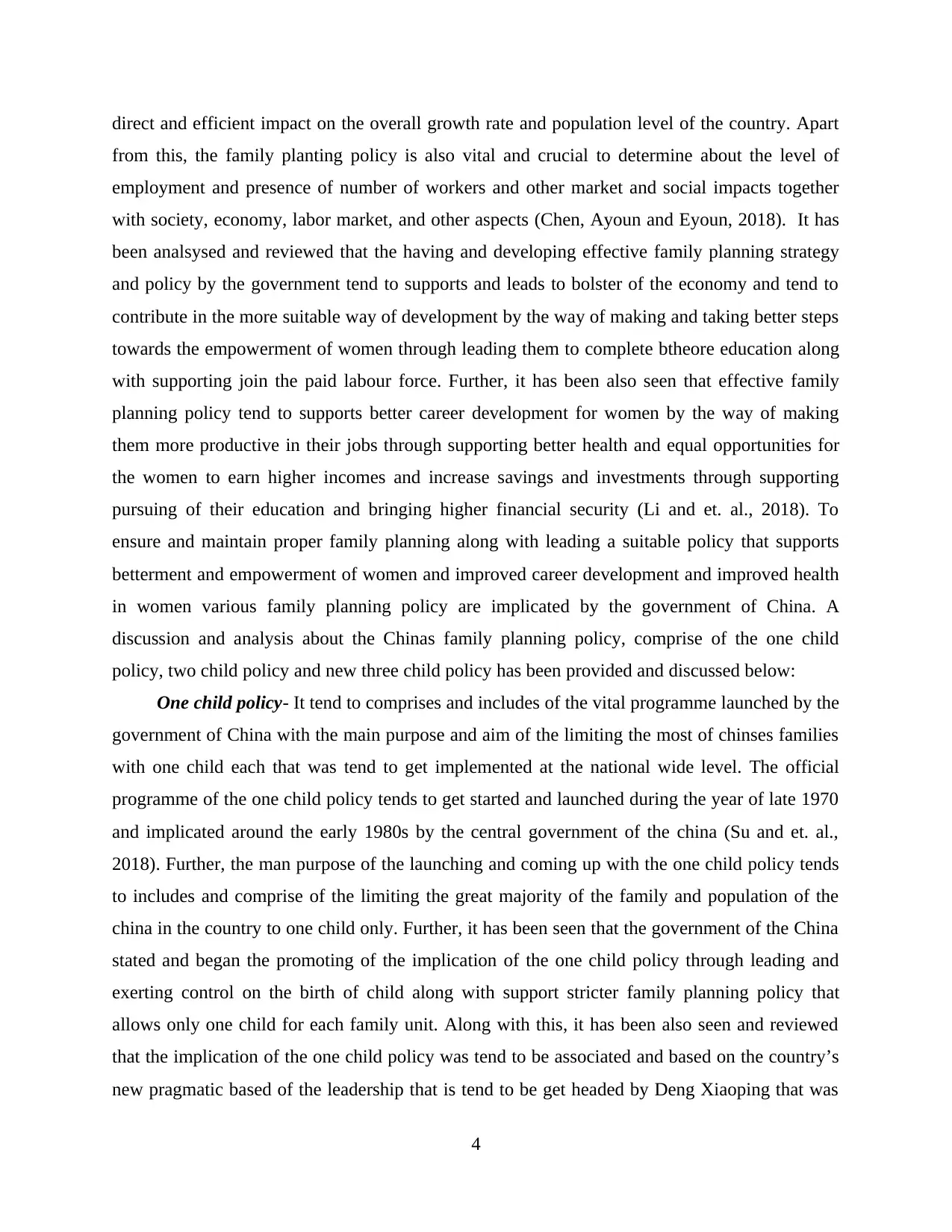
direct and efficient impact on the overall growth rate and population level of the country. Apart
from this, the family planting policy is also vital and crucial to determine about the level of
employment and presence of number of workers and other market and social impacts together
with society, economy, labor market, and other aspects (Chen, Ayoun and Eyoun, 2018). It has
been analsysed and reviewed that the having and developing effective family planning strategy
and policy by the government tend to supports and leads to bolster of the economy and tend to
contribute in the more suitable way of development by the way of making and taking better steps
towards the empowerment of women through leading them to complete btheore education along
with supporting join the paid labour force. Further, it has been also seen that effective family
planning policy tend to supports better career development for women by the way of making
them more productive in their jobs through supporting better health and equal opportunities for
the women to earn higher incomes and increase savings and investments through supporting
pursuing of their education and bringing higher financial security (Li and et. al., 2018). To
ensure and maintain proper family planning along with leading a suitable policy that supports
betterment and empowerment of women and improved career development and improved health
in women various family planning policy are implicated by the government of China. A
discussion and analysis about the Chinas family planning policy, comprise of the one child
policy, two child policy and new three child policy has been provided and discussed below:
One child policy- It tend to comprises and includes of the vital programme launched by the
government of China with the main purpose and aim of the limiting the most of chinses families
with one child each that was tend to get implemented at the national wide level. The official
programme of the one child policy tends to get started and launched during the year of late 1970
and implicated around the early 1980s by the central government of the china (Su and et. al.,
2018). Further, the man purpose of the launching and coming up with the one child policy tends
to includes and comprise of the limiting the great majority of the family and population of the
china in the country to one child only. Further, it has been seen that the government of the China
stated and began the promoting of the implication of the one child policy through leading and
exerting control on the birth of child along with support stricter family planning policy that
allows only one child for each family unit. Along with this, it has been also seen and reviewed
that the implication of the one child policy was tend to be associated and based on the country’s
new pragmatic based of the leadership that is tend to be get headed by Deng Xiaoping that was
4
from this, the family planting policy is also vital and crucial to determine about the level of
employment and presence of number of workers and other market and social impacts together
with society, economy, labor market, and other aspects (Chen, Ayoun and Eyoun, 2018). It has
been analsysed and reviewed that the having and developing effective family planning strategy
and policy by the government tend to supports and leads to bolster of the economy and tend to
contribute in the more suitable way of development by the way of making and taking better steps
towards the empowerment of women through leading them to complete btheore education along
with supporting join the paid labour force. Further, it has been also seen that effective family
planning policy tend to supports better career development for women by the way of making
them more productive in their jobs through supporting better health and equal opportunities for
the women to earn higher incomes and increase savings and investments through supporting
pursuing of their education and bringing higher financial security (Li and et. al., 2018). To
ensure and maintain proper family planning along with leading a suitable policy that supports
betterment and empowerment of women and improved career development and improved health
in women various family planning policy are implicated by the government of China. A
discussion and analysis about the Chinas family planning policy, comprise of the one child
policy, two child policy and new three child policy has been provided and discussed below:
One child policy- It tend to comprises and includes of the vital programme launched by the
government of China with the main purpose and aim of the limiting the most of chinses families
with one child each that was tend to get implemented at the national wide level. The official
programme of the one child policy tends to get started and launched during the year of late 1970
and implicated around the early 1980s by the central government of the china (Su and et. al.,
2018). Further, the man purpose of the launching and coming up with the one child policy tends
to includes and comprise of the limiting the great majority of the family and population of the
china in the country to one child only. Further, it has been seen that the government of the China
stated and began the promoting of the implication of the one child policy through leading and
exerting control on the birth of child along with support stricter family planning policy that
allows only one child for each family unit. Along with this, it has been also seen and reviewed
that the implication of the one child policy was tend to be associated and based on the country’s
new pragmatic based of the leadership that is tend to be get headed by Deng Xiaoping that was
4
⊘ This is a preview!⊘
Do you want full access?
Subscribe today to unlock all pages.

Trusted by 1+ million students worldwide
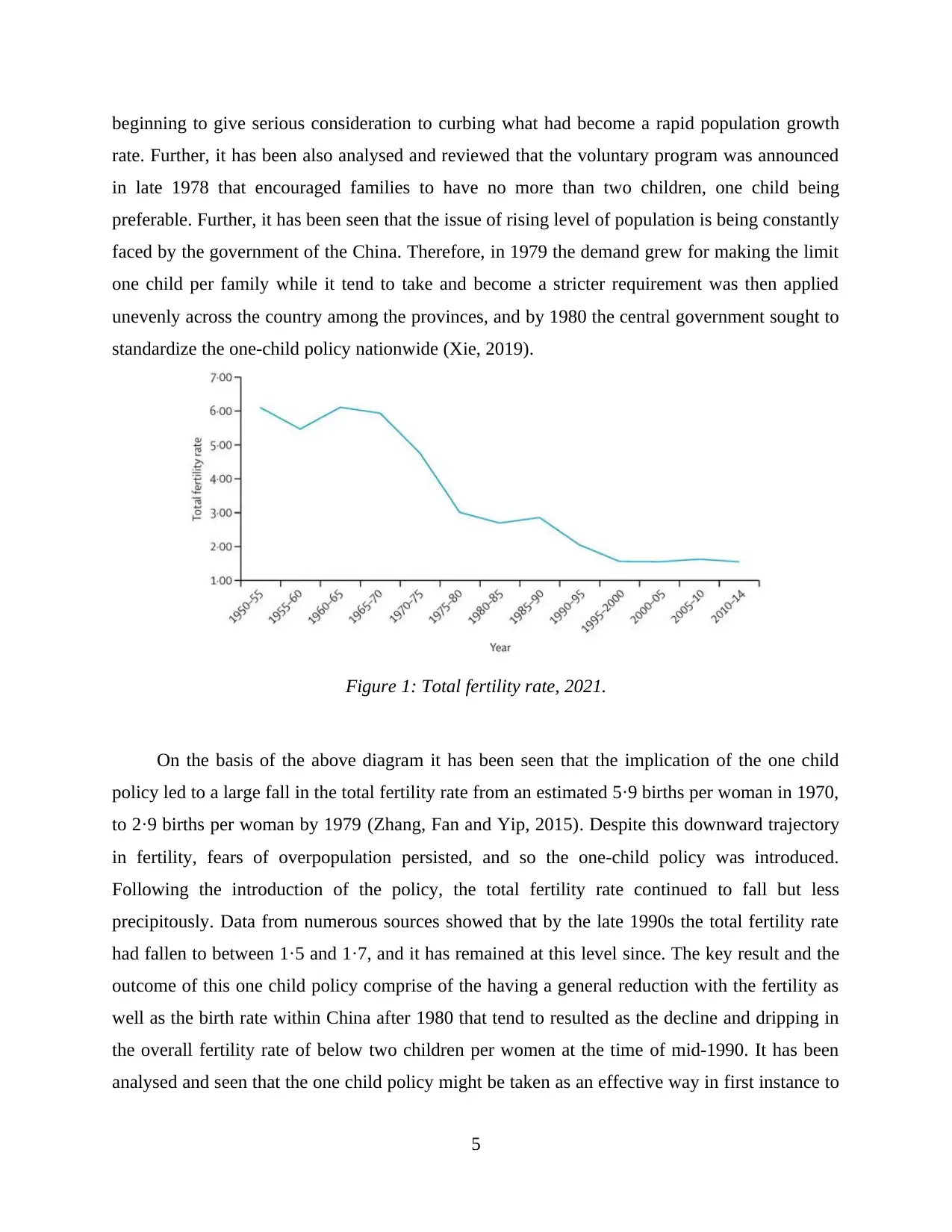
beginning to give serious consideration to curbing what had become a rapid population growth
rate. Further, it has been also analysed and reviewed that the voluntary program was announced
in late 1978 that encouraged families to have no more than two children, one child being
preferable. Further, it has been seen that the issue of rising level of population is being constantly
faced by the government of the China. Therefore, in 1979 the demand grew for making the limit
one child per family while it tend to take and become a stricter requirement was then applied
unevenly across the country among the provinces, and by 1980 the central government sought to
standardize the one-child policy nationwide (Xie, 2019).
Figure 1: Total fertility rate, 2021.
On the basis of the above diagram it has been seen that the implication of the one child
policy led to a large fall in the total fertility rate from an estimated 5·9 births per woman in 1970,
to 2·9 births per woman by 1979 (Zhang, Fan and Yip, 2015). Despite this downward trajectory
in fertility, fears of overpopulation persisted, and so the one-child policy was introduced.
Following the introduction of the policy, the total fertility rate continued to fall but less
precipitously. Data from numerous sources showed that by the late 1990s the total fertility rate
had fallen to between 1·5 and 1·7, and it has remained at this level since. The key result and the
outcome of this one child policy comprise of the having a general reduction with the fertility as
well as the birth rate within China after 1980 that tend to resulted as the decline and dripping in
the overall fertility rate of below two children per women at the time of mid-1990. It has been
analysed and seen that the one child policy might be taken as an effective way in first instance to
5
rate. Further, it has been also analysed and reviewed that the voluntary program was announced
in late 1978 that encouraged families to have no more than two children, one child being
preferable. Further, it has been seen that the issue of rising level of population is being constantly
faced by the government of the China. Therefore, in 1979 the demand grew for making the limit
one child per family while it tend to take and become a stricter requirement was then applied
unevenly across the country among the provinces, and by 1980 the central government sought to
standardize the one-child policy nationwide (Xie, 2019).
Figure 1: Total fertility rate, 2021.
On the basis of the above diagram it has been seen that the implication of the one child
policy led to a large fall in the total fertility rate from an estimated 5·9 births per woman in 1970,
to 2·9 births per woman by 1979 (Zhang, Fan and Yip, 2015). Despite this downward trajectory
in fertility, fears of overpopulation persisted, and so the one-child policy was introduced.
Following the introduction of the policy, the total fertility rate continued to fall but less
precipitously. Data from numerous sources showed that by the late 1990s the total fertility rate
had fallen to between 1·5 and 1·7, and it has remained at this level since. The key result and the
outcome of this one child policy comprise of the having a general reduction with the fertility as
well as the birth rate within China after 1980 that tend to resulted as the decline and dripping in
the overall fertility rate of below two children per women at the time of mid-1990. It has been
analysed and seen that the one child policy might be taken as an effective way in first instance to
5
Paraphrase This Document
Need a fresh take? Get an instant paraphrase of this document with our AI Paraphraser
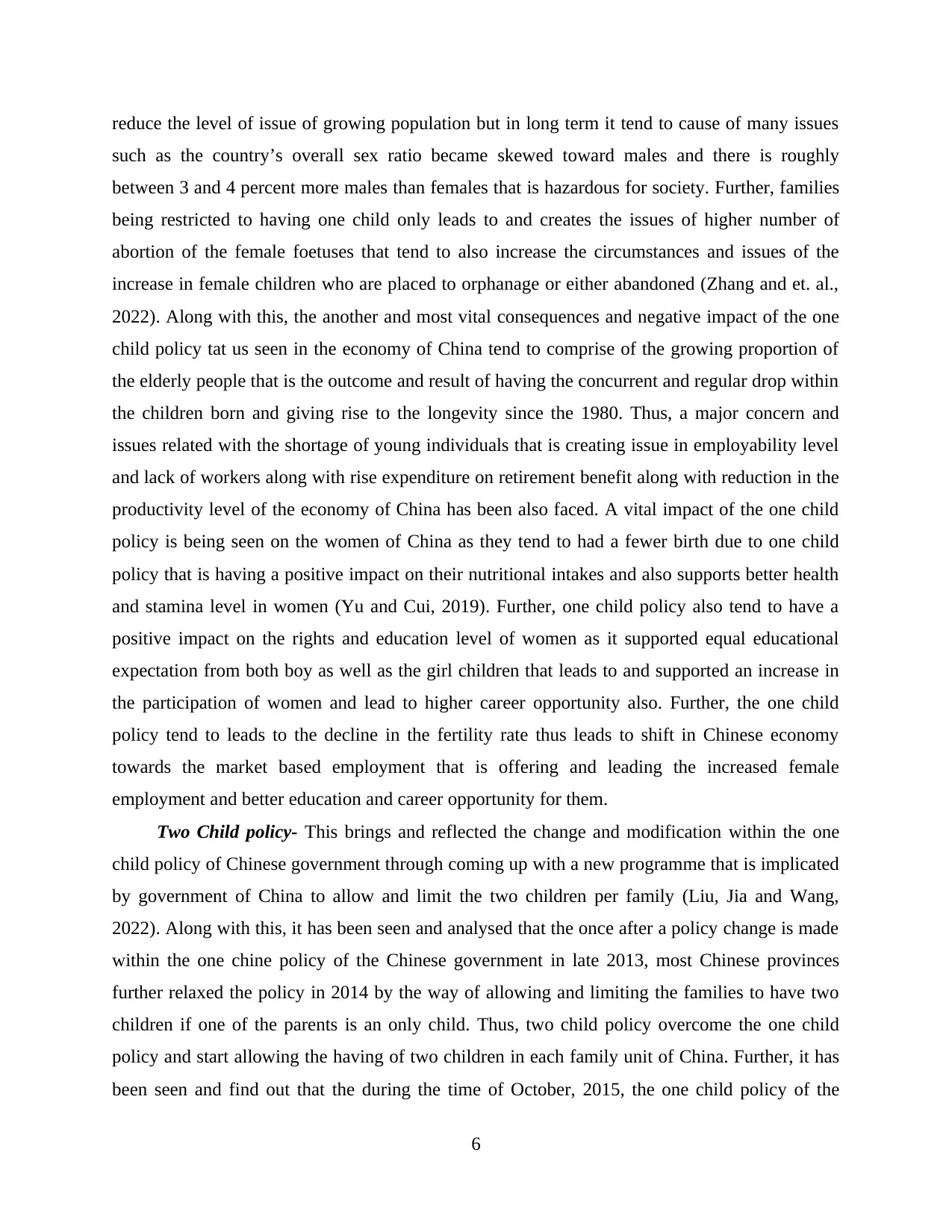
reduce the level of issue of growing population but in long term it tend to cause of many issues
such as the country’s overall sex ratio became skewed toward males and there is roughly
between 3 and 4 percent more males than females that is hazardous for society. Further, families
being restricted to having one child only leads to and creates the issues of higher number of
abortion of the female foetuses that tend to also increase the circumstances and issues of the
increase in female children who are placed to orphanage or either abandoned (Zhang and et. al.,
2022). Along with this, the another and most vital consequences and negative impact of the one
child policy tat us seen in the economy of China tend to comprise of the growing proportion of
the elderly people that is the outcome and result of having the concurrent and regular drop within
the children born and giving rise to the longevity since the 1980. Thus, a major concern and
issues related with the shortage of young individuals that is creating issue in employability level
and lack of workers along with rise expenditure on retirement benefit along with reduction in the
productivity level of the economy of China has been also faced. A vital impact of the one child
policy is being seen on the women of China as they tend to had a fewer birth due to one child
policy that is having a positive impact on their nutritional intakes and also supports better health
and stamina level in women (Yu and Cui, 2019). Further, one child policy also tend to have a
positive impact on the rights and education level of women as it supported equal educational
expectation from both boy as well as the girl children that leads to and supported an increase in
the participation of women and lead to higher career opportunity also. Further, the one child
policy tend to leads to the decline in the fertility rate thus leads to shift in Chinese economy
towards the market based employment that is offering and leading the increased female
employment and better education and career opportunity for them.
Two Child policy- This brings and reflected the change and modification within the one
child policy of Chinese government through coming up with a new programme that is implicated
by government of China to allow and limit the two children per family (Liu, Jia and Wang,
2022). Along with this, it has been seen and analysed that the once after a policy change is made
within the one chine policy of the Chinese government in late 2013, most Chinese provinces
further relaxed the policy in 2014 by the way of allowing and limiting the families to have two
children if one of the parents is an only child. Thus, two child policy overcome the one child
policy and start allowing the having of two children in each family unit of China. Further, it has
been seen and find out that the during the time of October, 2015, the one child policy of the
6
such as the country’s overall sex ratio became skewed toward males and there is roughly
between 3 and 4 percent more males than females that is hazardous for society. Further, families
being restricted to having one child only leads to and creates the issues of higher number of
abortion of the female foetuses that tend to also increase the circumstances and issues of the
increase in female children who are placed to orphanage or either abandoned (Zhang and et. al.,
2022). Along with this, the another and most vital consequences and negative impact of the one
child policy tat us seen in the economy of China tend to comprise of the growing proportion of
the elderly people that is the outcome and result of having the concurrent and regular drop within
the children born and giving rise to the longevity since the 1980. Thus, a major concern and
issues related with the shortage of young individuals that is creating issue in employability level
and lack of workers along with rise expenditure on retirement benefit along with reduction in the
productivity level of the economy of China has been also faced. A vital impact of the one child
policy is being seen on the women of China as they tend to had a fewer birth due to one child
policy that is having a positive impact on their nutritional intakes and also supports better health
and stamina level in women (Yu and Cui, 2019). Further, one child policy also tend to have a
positive impact on the rights and education level of women as it supported equal educational
expectation from both boy as well as the girl children that leads to and supported an increase in
the participation of women and lead to higher career opportunity also. Further, the one child
policy tend to leads to the decline in the fertility rate thus leads to shift in Chinese economy
towards the market based employment that is offering and leading the increased female
employment and better education and career opportunity for them.
Two Child policy- This brings and reflected the change and modification within the one
child policy of Chinese government through coming up with a new programme that is implicated
by government of China to allow and limit the two children per family (Liu, Jia and Wang,
2022). Along with this, it has been seen and analysed that the once after a policy change is made
within the one chine policy of the Chinese government in late 2013, most Chinese provinces
further relaxed the policy in 2014 by the way of allowing and limiting the families to have two
children if one of the parents is an only child. Thus, two child policy overcome the one child
policy and start allowing the having of two children in each family unit of China. Further, it has
been seen and find out that the during the time of October, 2015, the one child policy of the
6
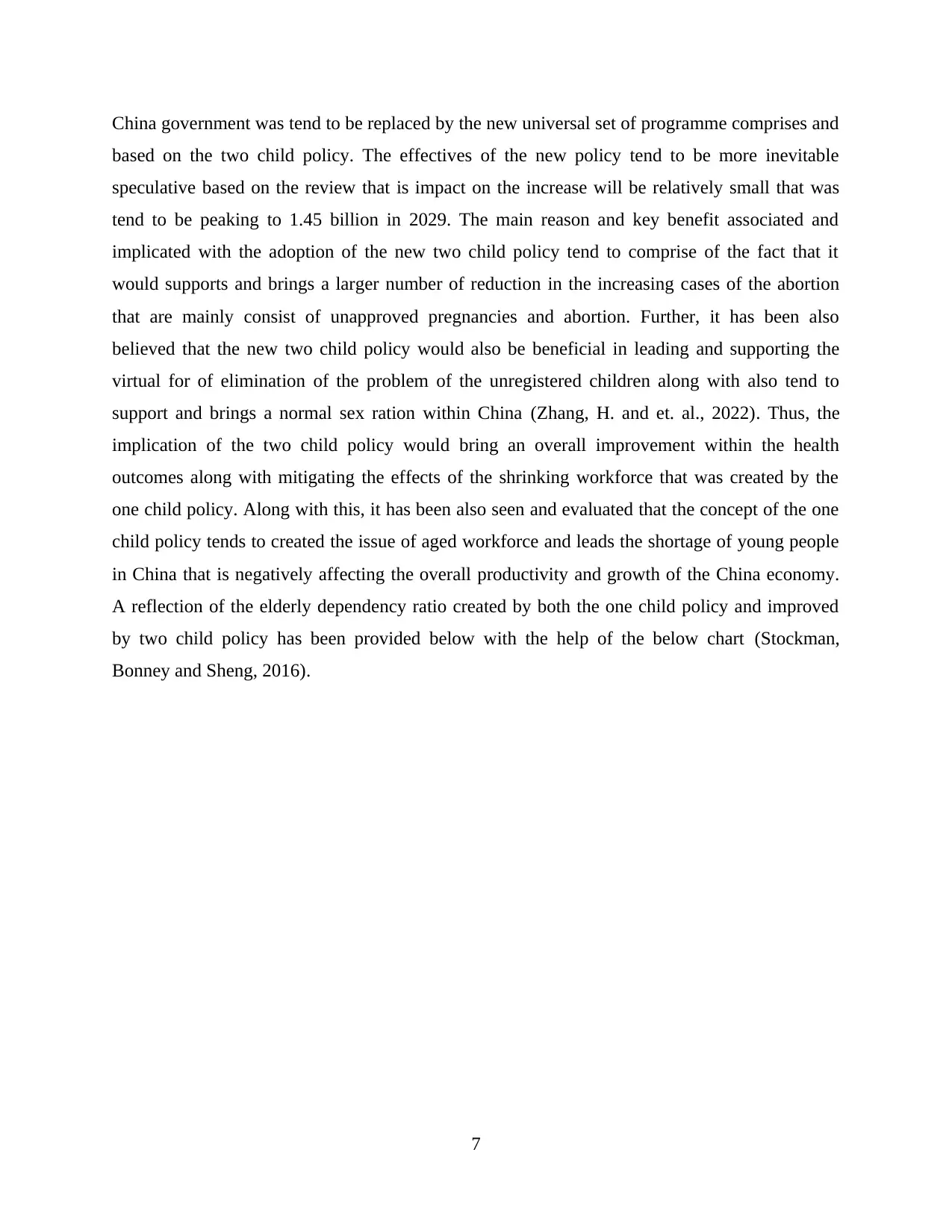
China government was tend to be replaced by the new universal set of programme comprises and
based on the two child policy. The effectives of the new policy tend to be more inevitable
speculative based on the review that is impact on the increase will be relatively small that was
tend to be peaking to 1.45 billion in 2029. The main reason and key benefit associated and
implicated with the adoption of the new two child policy tend to comprise of the fact that it
would supports and brings a larger number of reduction in the increasing cases of the abortion
that are mainly consist of unapproved pregnancies and abortion. Further, it has been also
believed that the new two child policy would also be beneficial in leading and supporting the
virtual for of elimination of the problem of the unregistered children along with also tend to
support and brings a normal sex ration within China (Zhang, H. and et. al., 2022). Thus, the
implication of the two child policy would bring an overall improvement within the health
outcomes along with mitigating the effects of the shrinking workforce that was created by the
one child policy. Along with this, it has been also seen and evaluated that the concept of the one
child policy tends to created the issue of aged workforce and leads the shortage of young people
in China that is negatively affecting the overall productivity and growth of the China economy.
A reflection of the elderly dependency ratio created by both the one child policy and improved
by two child policy has been provided below with the help of the below chart (Stockman,
Bonney and Sheng, 2016).
7
based on the two child policy. The effectives of the new policy tend to be more inevitable
speculative based on the review that is impact on the increase will be relatively small that was
tend to be peaking to 1.45 billion in 2029. The main reason and key benefit associated and
implicated with the adoption of the new two child policy tend to comprise of the fact that it
would supports and brings a larger number of reduction in the increasing cases of the abortion
that are mainly consist of unapproved pregnancies and abortion. Further, it has been also
believed that the new two child policy would also be beneficial in leading and supporting the
virtual for of elimination of the problem of the unregistered children along with also tend to
support and brings a normal sex ration within China (Zhang, H. and et. al., 2022). Thus, the
implication of the two child policy would bring an overall improvement within the health
outcomes along with mitigating the effects of the shrinking workforce that was created by the
one child policy. Along with this, it has been also seen and evaluated that the concept of the one
child policy tends to created the issue of aged workforce and leads the shortage of young people
in China that is negatively affecting the overall productivity and growth of the China economy.
A reflection of the elderly dependency ratio created by both the one child policy and improved
by two child policy has been provided below with the help of the below chart (Stockman,
Bonney and Sheng, 2016).
7
⊘ This is a preview!⊘
Do you want full access?
Subscribe today to unlock all pages.

Trusted by 1+ million students worldwide
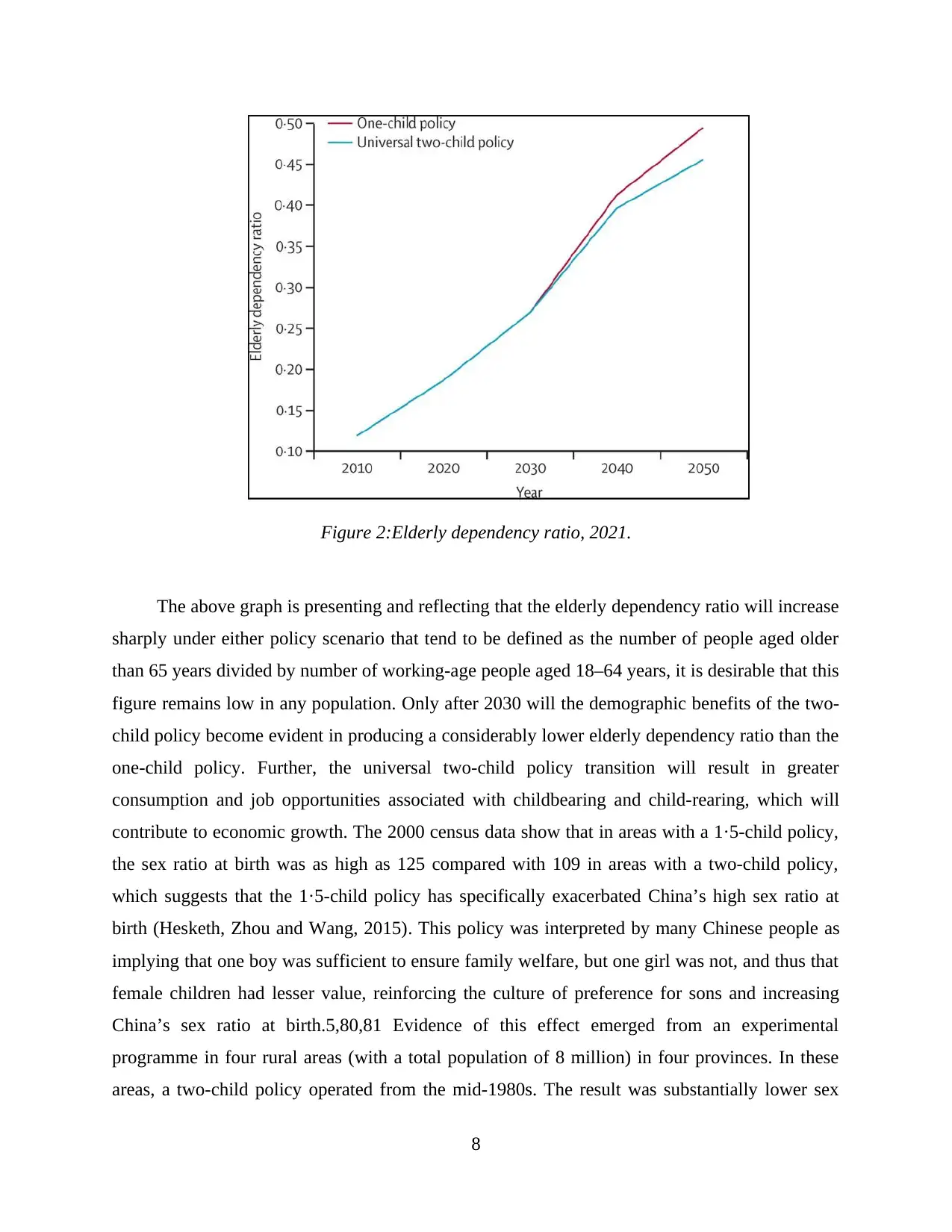
Figure 2:Elderly dependency ratio, 2021.
The above graph is presenting and reflecting that the elderly dependency ratio will increase
sharply under either policy scenario that tend to be defined as the number of people aged older
than 65 years divided by number of working-age people aged 18–64 years, it is desirable that this
figure remains low in any population. Only after 2030 will the demographic benefits of the two-
child policy become evident in producing a considerably lower elderly dependency ratio than the
one-child policy. Further, the universal two-child policy transition will result in greater
consumption and job opportunities associated with childbearing and child-rearing, which will
contribute to economic growth. The 2000 census data show that in areas with a 1·5-child policy,
the sex ratio at birth was as high as 125 compared with 109 in areas with a two-child policy,
which suggests that the 1·5-child policy has specifically exacerbated China’s high sex ratio at
birth (Hesketh, Zhou and Wang, 2015). This policy was interpreted by many Chinese people as
implying that one boy was sufficient to ensure family welfare, but one girl was not, and thus that
female children had lesser value, reinforcing the culture of preference for sons and increasing
China’s sex ratio at birth.5,80,81 Evidence of this effect emerged from an experimental
programme in four rural areas (with a total population of 8 million) in four provinces. In these
areas, a two-child policy operated from the mid-1980s. The result was substantially lower sex
8
The above graph is presenting and reflecting that the elderly dependency ratio will increase
sharply under either policy scenario that tend to be defined as the number of people aged older
than 65 years divided by number of working-age people aged 18–64 years, it is desirable that this
figure remains low in any population. Only after 2030 will the demographic benefits of the two-
child policy become evident in producing a considerably lower elderly dependency ratio than the
one-child policy. Further, the universal two-child policy transition will result in greater
consumption and job opportunities associated with childbearing and child-rearing, which will
contribute to economic growth. The 2000 census data show that in areas with a 1·5-child policy,
the sex ratio at birth was as high as 125 compared with 109 in areas with a two-child policy,
which suggests that the 1·5-child policy has specifically exacerbated China’s high sex ratio at
birth (Hesketh, Zhou and Wang, 2015). This policy was interpreted by many Chinese people as
implying that one boy was sufficient to ensure family welfare, but one girl was not, and thus that
female children had lesser value, reinforcing the culture of preference for sons and increasing
China’s sex ratio at birth.5,80,81 Evidence of this effect emerged from an experimental
programme in four rural areas (with a total population of 8 million) in four provinces. In these
areas, a two-child policy operated from the mid-1980s. The result was substantially lower sex
8
Paraphrase This Document
Need a fresh take? Get an instant paraphrase of this document with our AI Paraphraser
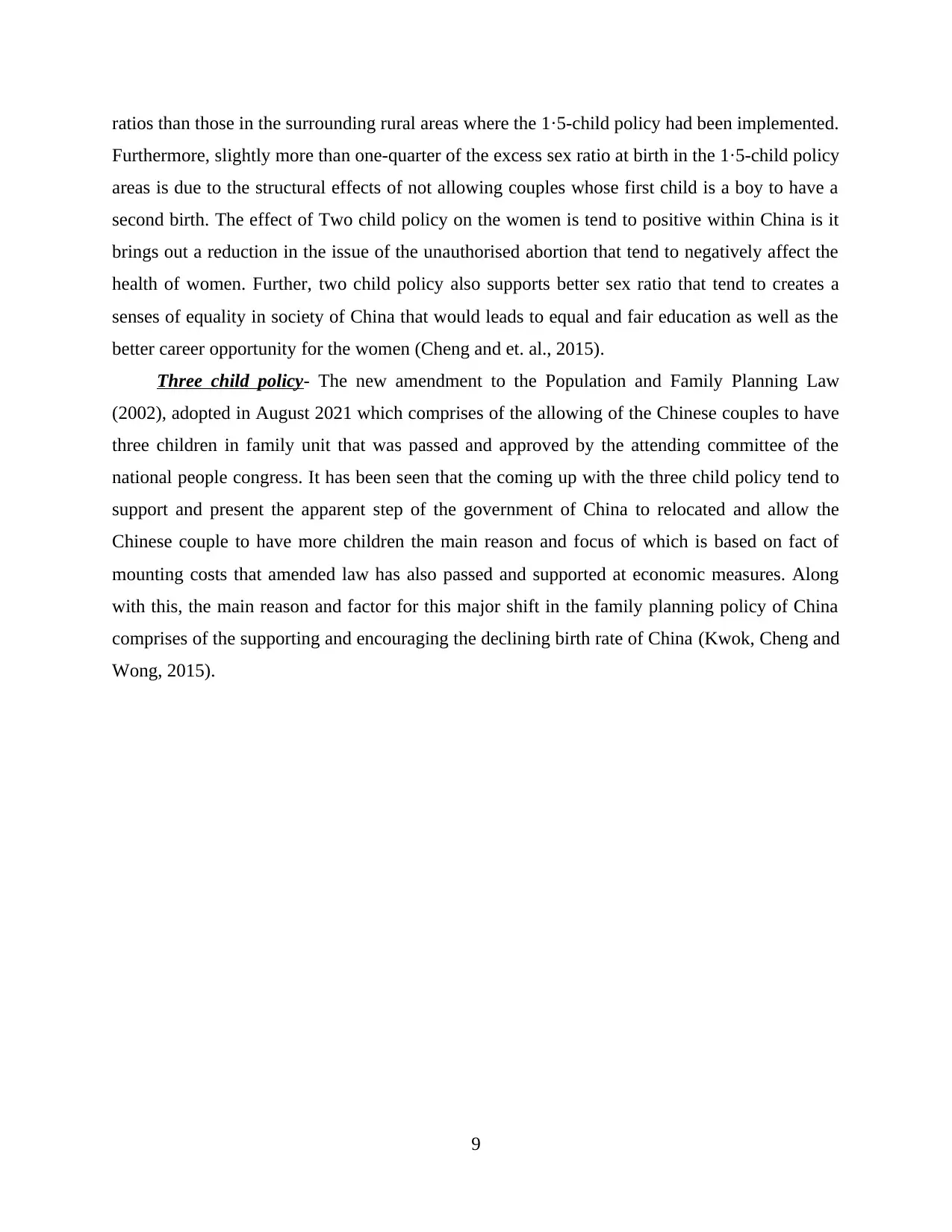
ratios than those in the surrounding rural areas where the 1·5-child policy had been implemented.
Furthermore, slightly more than one-quarter of the excess sex ratio at birth in the 1·5-child policy
areas is due to the structural effects of not allowing couples whose first child is a boy to have a
second birth. The effect of Two child policy on the women is tend to positive within China is it
brings out a reduction in the issue of the unauthorised abortion that tend to negatively affect the
health of women. Further, two child policy also supports better sex ratio that tend to creates a
senses of equality in society of China that would leads to equal and fair education as well as the
better career opportunity for the women (Cheng and et. al., 2015).
Three child policy- The new amendment to the Population and Family Planning Law
(2002), adopted in August 2021 which comprises of the allowing of the Chinese couples to have
three children in family unit that was passed and approved by the attending committee of the
national people congress. It has been seen that the coming up with the three child policy tend to
support and present the apparent step of the government of China to relocated and allow the
Chinese couple to have more children the main reason and focus of which is based on fact of
mounting costs that amended law has also passed and supported at economic measures. Along
with this, the main reason and factor for this major shift in the family planning policy of China
comprises of the supporting and encouraging the declining birth rate of China (Kwok, Cheng and
Wong, 2015).
9
Furthermore, slightly more than one-quarter of the excess sex ratio at birth in the 1·5-child policy
areas is due to the structural effects of not allowing couples whose first child is a boy to have a
second birth. The effect of Two child policy on the women is tend to positive within China is it
brings out a reduction in the issue of the unauthorised abortion that tend to negatively affect the
health of women. Further, two child policy also supports better sex ratio that tend to creates a
senses of equality in society of China that would leads to equal and fair education as well as the
better career opportunity for the women (Cheng and et. al., 2015).
Three child policy- The new amendment to the Population and Family Planning Law
(2002), adopted in August 2021 which comprises of the allowing of the Chinese couples to have
three children in family unit that was passed and approved by the attending committee of the
national people congress. It has been seen that the coming up with the three child policy tend to
support and present the apparent step of the government of China to relocated and allow the
Chinese couple to have more children the main reason and focus of which is based on fact of
mounting costs that amended law has also passed and supported at economic measures. Along
with this, the main reason and factor for this major shift in the family planning policy of China
comprises of the supporting and encouraging the declining birth rate of China (Kwok, Cheng and
Wong, 2015).
9
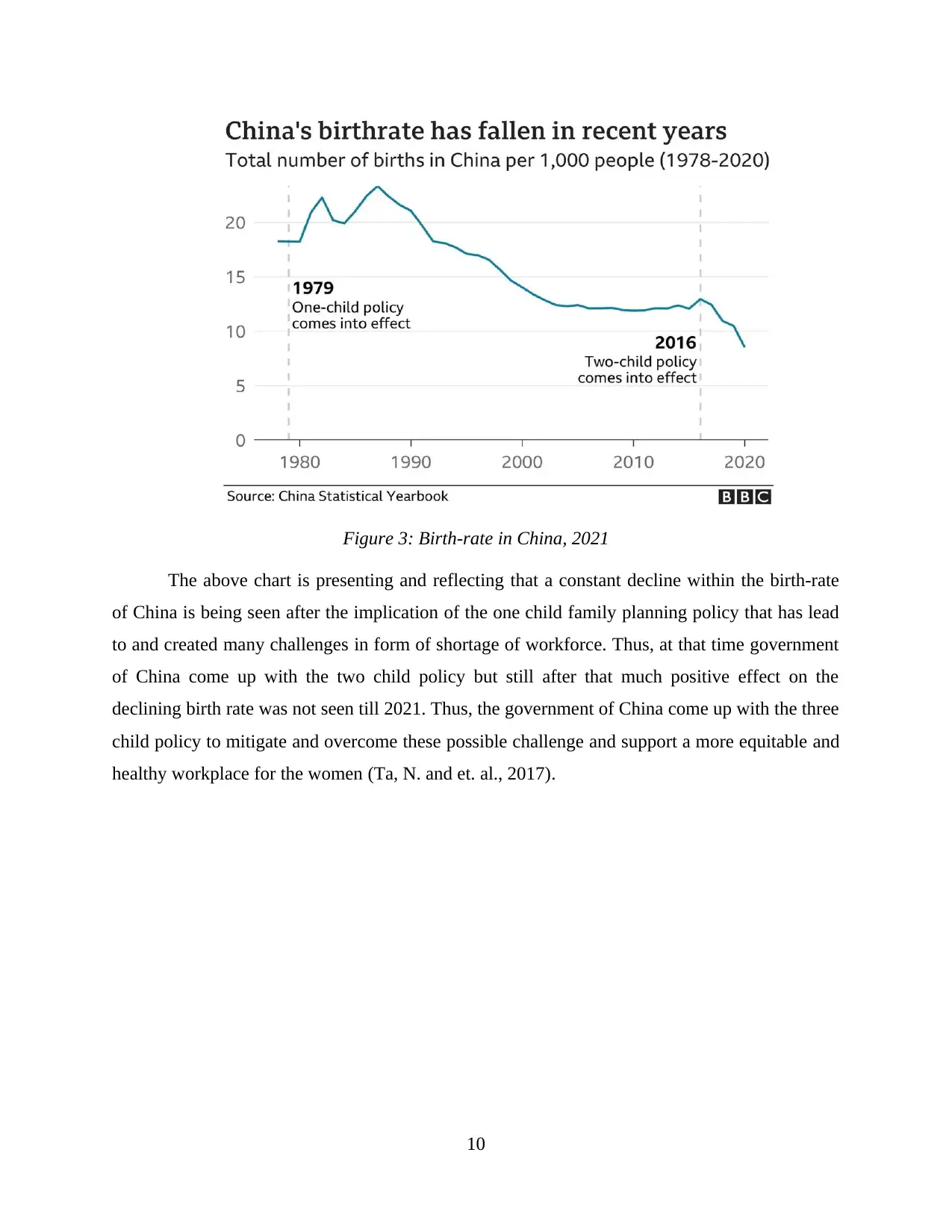
Figure 3: Birth-rate in China, 2021
The above chart is presenting and reflecting that a constant decline within the birth-rate
of China is being seen after the implication of the one child family planning policy that has lead
to and created many challenges in form of shortage of workforce. Thus, at that time government
of China come up with the two child policy but still after that much positive effect on the
declining birth rate was not seen till 2021. Thus, the government of China come up with the three
child policy to mitigate and overcome these possible challenge and support a more equitable and
healthy workplace for the women (Ta, N. and et. al., 2017).
10
The above chart is presenting and reflecting that a constant decline within the birth-rate
of China is being seen after the implication of the one child family planning policy that has lead
to and created many challenges in form of shortage of workforce. Thus, at that time government
of China come up with the two child policy but still after that much positive effect on the
declining birth rate was not seen till 2021. Thus, the government of China come up with the three
child policy to mitigate and overcome these possible challenge and support a more equitable and
healthy workplace for the women (Ta, N. and et. al., 2017).
10
⊘ This is a preview!⊘
Do you want full access?
Subscribe today to unlock all pages.

Trusted by 1+ million students worldwide
1 out of 29
Related Documents
Your All-in-One AI-Powered Toolkit for Academic Success.
+13062052269
info@desklib.com
Available 24*7 on WhatsApp / Email
![[object Object]](/_next/static/media/star-bottom.7253800d.svg)
Unlock your academic potential
Copyright © 2020–2025 A2Z Services. All Rights Reserved. Developed and managed by ZUCOL.





